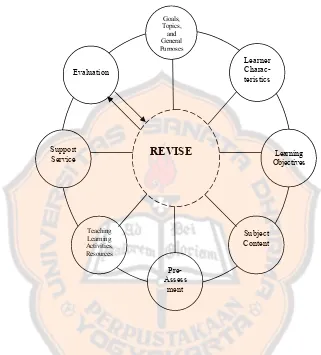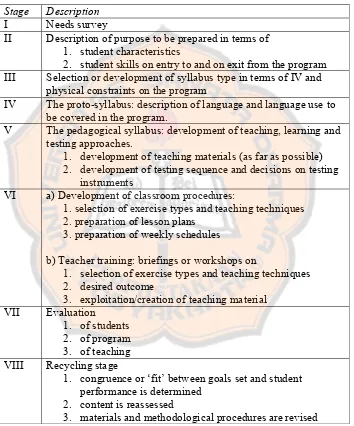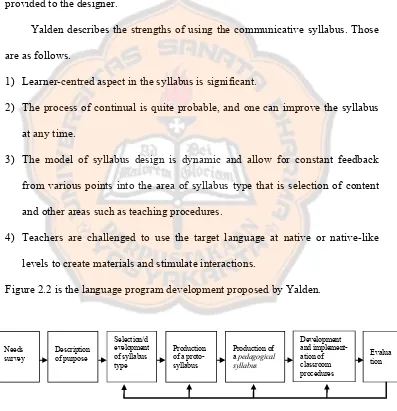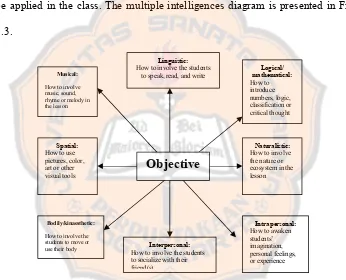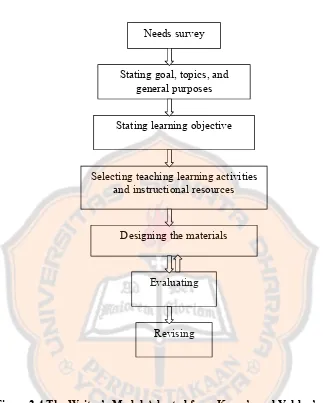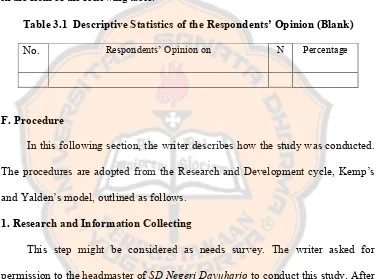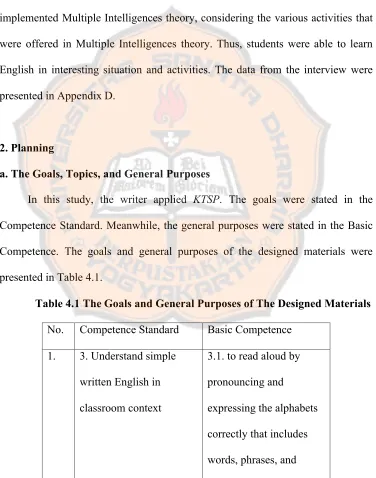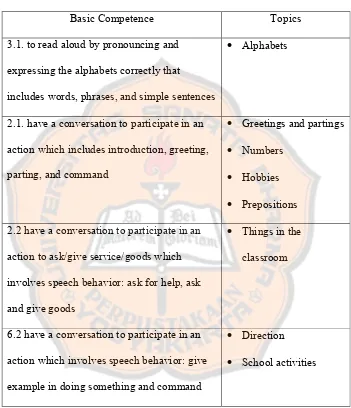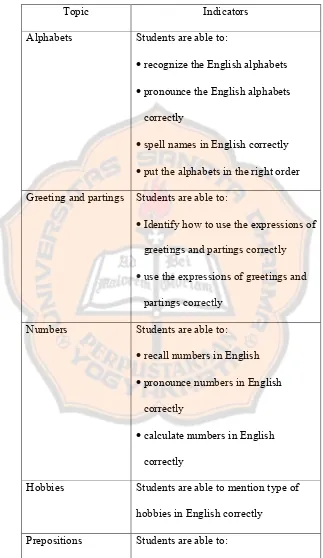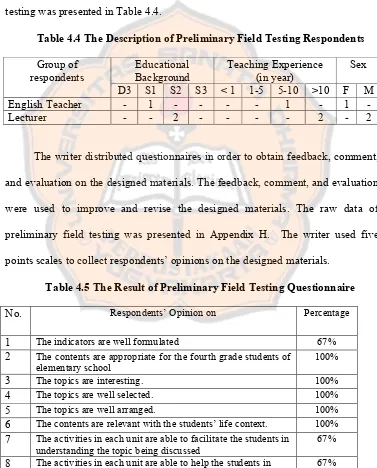DESIGNING A SET OF ENGLISH VOCABULARY INSTRUCTIONAL MATERIALS BASED ON MULTIPLE INTELLIGENCES FOR THE FOURTH GRADE STUDENTS OF SD NEGERI DAYUHARJO
YOGYAKARTA
A THESIS
Presented as Partial Fulfillment of the Requirements to Obtain the Sarjana Pendidikan Degree
in English Language Education
By Natalia Hardini Student Number: 051214119
ENGLISH LANGUAGE EDUCATION STUDY PROGRAM DEPARTMENT OF LANGUAGE AND ARTS EDUCATION FACULTY OF TEACHERS TRAINING AND EDUCATION
SANATA DHARMA UNIVERSITY YOGYAKARTA
i
DESIGNING A SET OF ENGLISH VOCABULARY INSTRUCTIONAL MATERIALS BASED ON MULTIPLE INTELLIGENCES FOR THE FOURTH GRADE STUDENTS OF SD NEGERI DAYUHARJO
YOGYAKARTA
A THESIS
Presented as Partial Fulfillment of the Requirements to Obtain the Sarjana Pendidikan Degree
in English Language Education
By Natalia Hardini Student Number: 051214119
ENGLISH LANGUAGE EDUCATION STUDY PROGRAM DEPARTMENT OF LANGUAGE AND ARTS EDUCATION FACULTY OF TEACHERS TRAINING AND EDUCATION
SANATA DHARMA UNIVERSITY YOGYAKARTA
iv
Proverbs 23: 18
“For surely there is an end; and
thine expectation shall not be cut
off.”
Dedicated to:
My Beloved Lord, Jesus Christ
My beloved parents, Heribertus Heru Suryadi and Ester Lely Susilo
My beloved brother and sister, Michael Dian Nugrahaand Katrin Margaret
My beloved grandmother, Marmiati
vii ABSTRACT
Hardini, Natalia. 2010. Designing a Set of English Vocabulary Instructional Materials Based on Multiple Intelligences for the Fourth Grade Students of SD Negeri Dayuharjo Yogyakarta. Yogyakarta: English Language Education Study Program, Sanata Dharma University.
The study is intended to design a set of English vocabulary instructional materials based on Multiple Intelligences for the fourth grade students of SD Negeri Dayuharjo Yogyakarta. There are eight types of intelligences; verbal-linguistics, logical-mathematical, visual-spatial, musical, bodily kinesthetic, interpersonal, intrapersonal, and naturalist. Children have their own unique interest in learning. Unfortunately, the students are provided monotonous activities that most of the activities only develop students’ linguistic intelligence.
There were two problems to be solved in this study. They were (1) How is a set of English vocabulary instructional materials based on multiple intelligences for the fourth grade students of SD Negeri Dayuharjo Yogyakarta designed? (2) What does the design of a set of English vocabulary instructional materials based on multiple intelligences for the fourth grade students of SD Negeri Dayuharjo Yogyakarta look like?
The writer applied research and development method in this study. To solve the first problem, the writer designed a set of instructional materials by combining Kemp’s and Yalden’s models. The combined model consists of eight steps that could be applied effectively in designing the materials. The steps were (1) conducting needs survey, (2) stating goal, topics, and general purposes, (3) Stating learning objective, (4) listing the subject contents, (5) developing the syllabus, (6) selecting teaching learning activities and instructional resources, (7) designing the materials, (8) evaluating and revising the designed materials.
To solve the second problem, the writer designed the materials. The materials consisted of eight units. Each unit was divided into four parts, namely Look, Listen and Repeat!, Let’s Practice!, Let’s Have Fun!, and Homework. Look, Listen, and Repeat! was the pre-activity. Let’s Practice! was a part where students provided with activities to accomplish the knowledge they have already acquired. Let’s Have Fun! was the post-activity, and Homework was the part where the students review the material individually. Each unit developed various intelligences. They were 5 to 8 intelligences which were developed in each unit. The designed materials had covered eight intelligences although the distribution of the intelligences was different.
The preliminary field testing showed that the percentage range for the designed materials was from 67% to 100%. It meant that the materials were good and acceptable. The writer hopes that this study will be useful for the fourth grade students and English teachers in elementary school who would like to apply this set of designed materials.
viii ABSTRAK
Hardini, Natalia. 2010. Designing a Set of English Vocabulary Instructional Materials Based on Multiple Intelligences for the Fourth Grade Students of SD Negeri Dayuharjo Yogyakarta. Yogyakarta: Program Studi Pendidikan Bahasa Inggris, Universitas Sanata Dharma.
Studi ini bertujuan untuk menyusun satu set materi kosakata Bahasa Inggris yang berdasarkan kecerdasan majemuk untuk siswa kelas empat SD Negeri Dayuharjo Yogyakarta. Ada delapan jenis kecerdasan: verbal-linguistik, matematis-logis, ruang-visual, kinestetik-badani, interpersonal, intrapersonal, dan alam. Anak-anak memiliki ketertarikan yang unik dalam pembelajaran. Tetapi, para siswa diberikan kegiatan yang monoton dimana sebagian besar kegiatannya hantya mengembangkan kecerdasan linguistik.
Terdapat dua permasalahan yang dibahas dalam studi ini. Permasalahan tersebut yaitu (1) Bagaimana satu set materi kosakata Bahasa Inggris yang berdasarkan kecerdasan majemuk untuk siswa kelas empat SD Negeri Dayuharjo Yogyakarta didesain? (2) Seperti apakah penyajian satu set materi kosakata Bahasa Inggris yang berdasarkan kecerdasan majemuk untuk siswa kelas empat SD Negeri Dayuharjo Yogyakarta?
Penulis menerapkan metode riset dan pengembangan dalam studi ini. Untuk memecahkan masalah pertama, penulis mendesain materi dengan mengkombinasikan model Kemp dan Yalden. Kombinasi tersebut terdiri dari delapan tahap yang dapat digunakan secara efektif dalam mendesain materi. adapun tahap-tahap tersebut adalah (1) melakukan survey kebutuhan siswa, (2) menentukan sasaran, topik, dan tujuan umum, (3) merumuskan indikator, (4) menyusun subjek isi, (5) mengembangkan silabus, (6) memilih aktifitas belajar mengajar dan sumbernya, (7) mendesain materi, (8) mengevaluasi dan memperbaiki materi yang telah didesain.
Untuk memecahkan masalah kedua, penulis mendeasain materinya. Materi yang didesain terdiri dari delapan unit. Setiap unit dibagi dalam empat bagian, yaitu Look, Listen and Repeat!, Let’s Practice!, Let’s Have Fun!, dan Homework. Setiap unit mengembangkan berbagai macam kecerdasan. Ada 5 sampai 8 kecerdasan yang dikembangkan pada setiap unit. Materi yang didesain telah mencakup delapan kecerdasan meskipun distribusi kecerdasannya berbeda-beda.
Evaluasi pra-area menunjukkan bahwa batas persentase pada materi yang didesain mulai dari 67% sampai 100%. Hal ini berarti bahwa materi yang didesain baik dan dapat diterima. Penulis berharap bahwa satu set materi ini dapat berguna untuk siswa keals empat sekolah dasar dan para guru Bahasa Inggris yang akan menggunakan materi ini.
ix
ACKNOWLEDGEMENTS
I praise my Lord Jesus Christ for His great blessing and gift by giving me
this beautiful life and also for His love. I thank Him for being my true friend who
is always by my side to face this life. I thank Him also for giving me those people
around me who always love me and support me. Therefore I would like to express
my gratitude to them.
My deep gratitude goes to Christina Kristiyani, S.Pd., M.Pd. who has
guided me patiently in the writing process of this thesis and has given me the time
for consultation on this thesis until it is done.
My thank and gratitude also go to the headmaster of SD Negeri
Dayuharjo, Suyati, S.Pd., for allowing me to do my research and Fatimah, S.Pd.,
the English teacher who has given time, help, and willingness to evaluate my
designed materials. I also thank Drs. Y. B. Gunawan, M.A and Gregorius Punto
Aji, S.Pd., M.Pd. for their willingness to evaluate and give comments on my
designed materials.
I thank Sanata Dharma University, mostly the English Language
Education Study Program, for giving me a nice place to study. I also express my
gratitude to all my lecturers who have shared their knowledge and experiences
with me. I thank all the staff of Teachers Training and Education Faculty for the
services given since I began studying in this university.
With lots of love, I thank my beloved parents, Heribertus Heru Suryadi
x
in every single day of my life. I thank them for the remarkable efforts they made
in order to educate me. My gratitude also goes to my brother Michael Dian
Nugraha, my grandmother Marmiati, and my sister in law Katrin Margaret for
their prayer, always asking about the progress of my study, and also supporting
me in finishing my thesis.
Lots of thanks go to my beloved friends, Nia Cemplux and Eagle Camp
crew, all ESBC crew, “Oma” Mega, Youth Pastor -Ko Jimmy- and especially for my beloved best friends, Lina, Agung and Jemz. I would also like to thank all my
classmates in English Language Education of 2005, especially Neng Ophi, Teteh Dita, TimTim, Patrice, and Anis. I thank them very much for giving me their
support and friendship during my study time in PBI and for giving me motivation
so I can finish my duty. I also thank them for laughter, memories and togetherness
that have colored my life.
My special thanks go to my spiritual leader Daddy Widhi, for being
patient and always supporting me, my great cell group, House of Revival, who
always support, pray for me and for every kindness they have given to me.
Last but not least, I would like to thank everyone that I cannot mention
one by one, who has given me support and attention in the process of writing this
thesis. May God bless them all.
xi
TABLE OF CONTENTS
TITLE PAGE ………..………... PAGES OF APPROVAL ……….………..………... PAGE OF DEDICATION ……….... STATEMENT OF WORK’S ORIGINALITY ..………. PAGE OF PUBLICITY ……… ABSTRACT ………..……….
ABSTRAK……….……….
ACKNOWLEDGEMENTS ………..… TABLE OF CONTENTS ………..…… LIST OF TABLES ………..……….. LIST OF FIGURES ………..……… LIST OF APPENDICES ………..……
CHAPTER 1 INTRODUCTION ………... A. Research Background ...………..……….. B. Problem Formulation ...………..………... C. Problem Limitation .……….. D. Research Objectives ...………..………. E. Research Benefits ...………..………. F. Definition of Terms ...………..…..
xii
CHAPTER 2 REVIEW OF RELATED LITERATURE ...………..…. A. Theoretical Description ...………..……. 1. Instructional Materials Design Models ...……….…..……. a. Kemp’s Model ...….………...…………..…… b. Yalden’s Model ...………...……….…….……... 2. Foreign Language Learning for Children………...……… a. Child Development and Characteristics ...………..……. b. Principle of Children Language Learning ...………..…….. 3. Multiple Intelligences Theory ..………..….. a. Types of Multiple Intelligences ...……..………..……. b. Learners’ Characteristics Based on Multiple Intelligences
Theory ...……….. c. Applying Multiple Intelligences in the Classroom ...………..…. d. English Learning Activities through Multiple Intelligences ….... 4. Theory on Vocabulary ..………... a. The Nature of Teaching Vocabulary ………..….. b. The Importance of Vocabulary ………..……….. B. Theoretical Framework ………..…………
CHAPTER 3 METHODOLOGY .………... A. Research Method ....………..…... B. Research Participants ...………...…………... C. Research Instruments ……….……
xiii
D. Data Gathering Technique ………...…… E. Data Analysis Technique ...………..…...…… F. Procedure ...………....………..………...……
CHAPTER 4 RESEARCH FINDINGS AND DISCUSSIONS ...………..… A. The Designing Process of the Multiple Intelligences Based
Instructional Vocabulary Materials ...………... 1. Information Collecting ...………... a. Students’ Needs Based on the Questionnaire ..……….……..…. b. Students’ Needs Based on the Interview ...……….………. 2. Planning ………..……… a. The Goal, Topics, and General Purposes ……….…………... b. The Learning Objectives .………....……..………... c. The Subject Contents ..………..………... d. The Syllabus ……...………..……… e. The Teaching Activities and Instructional Resources ...……..…. 3. Developing Preliminary Form of Products …...…………..……... 4. Preliminary Field Testing ………..………... 5. Final Product Revisions ………... B. Findings and Discussions on the Designed Materials Evaluation .…. 1. Preliminary Field Testing ……….……...……… a. The Discussion of The Designed Materials ...……….………… b. Respondents’ Comments and Suggestions on the Designed
xiv
2. Final Product Revision ………..………... C. The Designed Materials ………....…..…………...
CHAPTER 5 CONCLUSIONS AND SUGESTIONS ………..……….. A. Conclusions ...………...……….. B. Suggestions ...………..…..………..
REFERENCES ………..……… 55 56
63 63 65
xv
LIST OF TABLES Table
2.1 Stages in Language Program Development by Yalden……….
3.1 Descriptive Statictics of Respondents’ Opinion (Blank)………...
4.1 The Goals and General Purposes of the Designed Materials…………
4.2 The Topics……….
4.3 The Indicators of Each Topic……….…
4.4 The Description of Preliminary Field Testing Respondents………….
4.5 The Result of Preliminary Field Testing Questionnaire………
4.6 The Summarization of Intelligences Developed in Each Unit……….
Page
14
41
44
45
47
51
51
xvi
LIST OF FIGURES
Figure
2.1 Kemp’s Instructional Design Model …………..……….
2.2 Yalden’s Model: Language Program Development ……..…………...
2.3 Multiple Intelligences Diagram ...………...
2.4 The Writer’s Model Adapted from Kemp’s and Yalden’s Model …..……
Page
13
xvii
LIST OF APPENDICES
Appendix A Letter of Permission ……….
Appendix B Questionnaire of the Needs Survey ..………...
Appendix C The Result of Questionnaire on the Needs Survey ..…….
Appendix D The Result of the Interview on the Needs Survey ...……..
Appendix E Syllabus ...………..
Appendix F Lesson Plan ………...
Appendix G Learning Activities and Intelligences Being Developed ...
Appendix H Questionnaire on the Evaluation Survey ...………
Appendix I The Result of Questionnaire on the Evaluation Survey ...
Appendix J The General Description of the Designed Materials ....…..
Appendix K Presentation of the Designed Materials ...…….…………..
Page
69
70
74
76
78
84
100
105
108
110
1 CHAPTER I
INTRODUCTION
This chapter presents the introduction that is divided into six parts. The first part is the explanation of the research background. The discussion of the problem formulation is on the second part. Then, on the third part is the explanation of the problem limitation. The explanation of research objectives takes the fourth part of this chapter. The fifth part is the discussion of research benefits, and the last part elaborates the definition of terms.
A. Research Background
learn at the higher level of learning a language. Based on Anderson’s (1980: 394), children at the age of two until eleven years old are in a critical period. Children in those ages are easier to learn a language.
In learning a language, the very first stage is learning its vocabulary. Laufer states that “no text comprehension is possible, either in one’s native language or in a foreign language, without understanding the text’s vocabulary” (in Coady and Huckin, 1997: 20). It emphasizes that vocabulary teaching is the main component of language teaching. In order to make the teaching interesting, teachers have to be creative in designing materials for the students. Teachers have to recognize that “not all children exhibit the same intelligence profile, nor do they share the same interests.” (Campbell, 1996: xxi). Teaching language, especially teaching English is not just a matter of delivering knowledge but also leads the students applying the language in their real life.
English is introduced and taught as one of the elementary school subjects in Indonesia after the government considering its importance. English has been introduced as a local content subject for the fourth grade of elementary school students based on the government decision. The students of fourth grade are appropriate to be introduced English because they are very dynamic and still very active.
various activities in order to reduce boredom and frustration in children. Besides, these activities might change students’ point of view on English.
Some of Elementary school materials emphasize on teachers as the center of the class. Meaning to say, here, the materials depend on the teacher’s capability in giving explanations so that the students understand the lesson. Moreover, most of the exercises offer questions which have to answer orally or written. These activities might cause boredom. This situation happens in SD Negeri Dayuharjo. Concerning this situation, the writer employs the theory of multiple intelligences to vary the activities. Besides, vocabulary materials are appropriate for the fourth grade students of SD Negeri Dayuharjo because the students are considered as beginner in learning English.
The theory of multiple intelligences offers various activities that can be used in teaching English for the fourth grade of elementary school. Children may learn English through words, numbers, pictures, music, movement, social-interaction, self-understanding and natural experience. The use of those eight types of intelligences as teaching techniques will be helpful for English teachers to accommodate students’ interests and talents. By the various activities offered, such as using music or songs, cooperative learning, multimedia, field trip, role play, art activities, and many more, teachers will not give monotonous teaching activity. The expectation from these various activities is that the students will enjoy and be interested in learning English.
logical-mathematical intelligence, spatial intelligence, bodily-kinesthetic intelligence, interpersonal intelligence, intrapersonal intelligence and naturalist intelligence (1993). The vocabulary instructional material based on multiple intelligences is designed in order to make the learning more attractive and not monotonous.
B. Problem Formulation
Considering the previous explanation of the research background, the problems of the study are formulated as follows.
1. How is a set of English vocabulary instructional materials based on multiple intelligences for the fourth grade of SD Negeri Dayuharjo Yogyakarta designed?
2. What does the design of a set of English vocabulary instructional materials based on multiple intelligences for the fourth grade of SD Negeri Dayuharjo Yogyakarta look like?
C. Problem Limitation
In this study, the writer focuses on designing a set of English vocabulary materials based on multiple intelligences, not on implementing the materials. The writer chooses the fourth grade students of SD Negeri Dayuharjo. Moreover, the writer considers that students in the fourth grade are appropriate to learn English and study English with various activities will not make the students feel bored.
Thus, this study uses linguistic intelligence, logical-mathematical intelligence, spatial intelligence, bodily-kinesthetic intelligence, interpersonal intelligence, intrapersonal intelligence and naturalist intelligence.
D. Research Objectives
Related to the problem formulations above, the writer states the objective concerning this study as follows.
1. To develop a set of English vocabulary instructional materials based on multiple intelligences for the fourth grade of SD Negeri Dayuharjo Yogyakarta
2. To present the designed English vocabulary instructional materials based on multiple intelligences for the fourth grade of SD Negeri Dayuharjo Yogyakarta.
E. Research Benefits
This research is expected to give benefit to all parties dealing with the learning of English in the elementary school. The result of the research will provide valuable contributions to the following parties.
1. English teachers
and interesting activities. Besides, teachers will accommodate students’ interests and talents with these materials.
2. The fourth grade students of SD Negeri Dayuharjo
The students will experience various activities to improve their interest in learning English and stimulate their intelligences by applying the materials. They will also be appreciated as an individual who is unique from the others. Moreover, they will enjoy the teaching and learning process.
3. Other researchers
This study has limitation because it is only designing not implementing. Hopefully, this study may offer contribution for other researchers in designing and implementing these designed materials to find out the strengths, weaknesses, and effectiveness.
4. The writer
For the writer, this study provides more knowledge in designing materials and new perspectives in teaching English through Multiple Intelligences with various activities.
F. Definition of Terms
All the terms used in this research are defined in such a way that they will fit the topic as well as the objective of the research.
1. Design
may rise in teaching and learning process can be minimized by designing the teaching materials (1978:230). The design contains lesson plan, various activities, learning objectives, and subject areas to learn which fit to the students. Thus, design in this study means developing a set of materials which might fulfill students’ needs and interest in learning English vocabulary.
2. Instructional Materials
In defining instructional materials, it will be better to know the definition of instructional design. Instructional design is “defined as a systematic process of designing the materials made by the teacher or instructional designer for the teaching instructions” (Dick and Reiser, 1989:58). Therefore, instructional materials can be defined as developed materials that use a design involving the systematic process of designing, developing, implementing, and evaluating. Instructional materials might be in the form of printed materials, computer assisted instruction and television instruction. In this study, the instructional materials refer to a set of English materials designed to develop the previous English materials used in the classroom. The instructional materials would be in the form of printed materials for the fourth grade students of SDN Dayuharjo. 3. Vocabulary
topics which are alphabets, greetings, numbers, hobbies, prepositions, things in the classroom, directions, and school activities.
4. Multiple Intelligences
Multiple intelligences is defined as “a learner-based philosophy that characterizes human intelligence as having multiple dimensions that must be acknowledged and developed in education” (Richards& Rodger, 2001: 115). These intelligences consist of nine intelligences namely linguistic intelligence, logical-mathematical intelligence, spatial intelligence, bodily-kinesthetic intelligence, interpersonal intelligence, intrapersonal intelligence, naturalist intelligence, and existential intelligence (Suparno, 2004: 25-44). Multiple intelligences in this study refer to the eight types of intelligences which are linguistic intelligence, logical-mathematical intelligence, spatial intelligence, bodily-kinesthetic intelligence, interpersonal intelligence, intrapersonal intelligence and naturalist intelligence.
5. Elementary school students
9 CHAPTER II
REVIEW OF RELATED LITERATURE
This chapter presents a discussion upon which the study was developed. There are two parts of discussion namely theoretical description and theoretical framework. The theoretical description presents a detailed description of concepts related to the research. In the theoretical framework, the writer relates the theories discussed to the research.
A. Theoretical Description
The theoretical description presents the theories which are the basis of this study. Those theories consist of theories about instructional design models, foreign language learning for children, multiple intelligences theory, and theory on vocabulary.
1. Instructional Materials Design Models
In this subsection, the writer describes two instructional design models that are Kemp’s model and Yalden’s model.
a. Kemp’s Model
The instructional design plan is produced to answer three questions which are considered as the essential elements (Kemp, 1977: 8). The three questions are as follows.
1. What must be learned?
2. What procedures and resources will work best to reach the desired learning levels?
3. How will we know when the required learning has taken place?
The first question focuses on the designed plan objectives. The second focuses on the activities and resources of the designed material while the last question focuses on the evaluation to assess the teaching and learning activities.
Kemps proposes a development program to answer those three questions which consists of eight parts (1977: 8-9). They are as follows.
1. Considering goals, topics, and the general purposes for teaching each topic All educational programs are based on broad stated goals. Kemp’s instructional design planning begins with the formulation of the goals before designing the materials. After considering the goals, the next step is listing the major topics for the study. The topics are sequenced from simple to the complicated level. Then, the general purposes are determined to be accomplished for each topic. It is possible for a single topic to have more than one purpose. 2. Enumerating the learners’ characteristics
conditions and learning styles. Knowing the learners’ characteristics is important since it will be useful for instructions determination.
3. Specifying the learning objectives
The designer should specify the learning objectives to be achieved by the students as the behavioural outcomes. The learning objectives are grouped into three major categories: cognitive, psychomotor, and affective. Kemp states that objectives tell the students what goals they have to achieve.
4. Listing the subject content
This part is performed in order to clarify the learning objectives. Therefore, the subject content has to reflect the learning objectives and learners’ needs. The designer must organize and sequence the subject content in various ways depends on the topic. Kemp proposed questions that should be asked by the designer in listing the subject content; those are: 1) what specifically the students must learn in the topic, 2) what facts, concepts, and principles relate to the topic, 3) what steps that the teacher should do in teaching the topic, 4) what techniques that the teacher should use in teaching the topic (1977: 45). By answering these questions, the designer is able to list the subject content.
5. Developing pre-assessments
efficiency. It will also be helpful in assisting the designer to group the learners based on their background.
6. Selecting teaching/learning activities and instructional resources
The activities and resources help the learners to accomplish the learning objectives through the subject content under the teaching learning activities. The designer must establish the most effective and efficient methods. Then, choose materials in order to provide learning experiences.
7. Coordinating support services
The designer should consider the support services such as budget, facilities, equipment, time and schedules to carry out the instructional plan, and coordination with other activities. These services must be considered at the same time as instructional plans are being selected and being made. In other words, instructional design plan cannot be formed without support services.
8. Evaluating the students’ learning
This last part is used to measure the learning outcomes related to the objectives. The evaluation leads the instructional material designer to revise any phase of the plan that needs improvement.
Kemp’s instructional design model has strengths and weakness (Soekamto, 1993: 28). The strengths are as follows.
1) The process of instructional design and development may begin anywhere. 2) There is an emphasis on goals, uses, and also on the choice of resources.
Kemp’s instructional design model is illustrated Figure 2.1.
b. Yalden’s Model
The writer utilizes Yalden’s instructional model since its model provides clear stages on needs survey. This instructional model has been designed to identify the students’ needs in learning. Thus, improvement in learning outcome might be done. Yalden’s model emphasizes on communicative functions, which
Goals, Topics, and General Purposes
Learner Charac-teristics
Learning Objectives Support
Service
Teaching Learning Activities, Resources
Subject Content
Pre-Assess
ment Evaluation
REVISE
means to ensure the learners’ acquisition to communicate in more appropriate and efficient way (Yalden, 1987: 86-87). Janice Yalden sets out eight stages in language program development, presented in Table 2.1.
Table 2.1. Stages in Language Program Development by Yalden (1987: 89)
Stage Description
I Needs survey
II Description of purpose to be prepared in terms of 1. student characteristics
2. student skills on entry to and on exit from the program III Selection or development of syllabus type in terms of IV and
physical constraints on the program
IV The proto-syllabus: description of language and language use to be covered in the program.
V The pedagogical syllabus: development of teaching, learning and testing approaches.
1. development of teaching materials (as far as possible) 2. development of testing sequence and decisions on testing
instruments
VI a) Development of classroom procedures:
1. selection of exercise types and teaching techniques 2. preparation of lesson plans
3. preparation of weekly schedules
b) Teacher training: briefings or workshops on
1. selection of exercise types and teaching techniques 2. desired outcome
3. exploitation/creation of teaching material VII Evaluation
1. of students 2. of program 3. of teaching VIII Recycling stage
1. congruence or ‘fit’ between goals set and student performance is determined
2. content is reassessed
The eight stages will be discussed further as follows.
Stage 1: Needs Survey
This first stage is aimed at gathering information to understand the needs of learners in order to determine realistic and acceptable objectives, “a primary objective was to lay a good foundation” (Yalden, 1987: 101). Thus, the designer should collect information, which covers who the learners are and what are their purposes, needs and wishes are in learning the language. In other words, there are two categories should be covered as Yalden explained that what they bring with them and where they are going (1987: 103-104).
Stage 2: Description of Purpose
The second stage is carried out after having done the needs survey since the data gathered will be the basis in developing the purpose of the program. Yalden stated that “the more accurately one can predict what the learners’ language or communicative needs will be, the more clearly the content of a syllabus can be delineated” (1987: 105). It means that the purpose of the language program is clarified as the foundation for the designer before selecting a syllabus type, the next stage.
Stage 3: Selection or Development of Syllabus Type
might combine more than one syllabus in order to get the most suitable and reliable syllabus design.
Stage 4: Production of Proto-syllabus
This stage describes the content of the syllabus will have. In other words, it describes the language and language use to be covered in the program. The information gathered from the needs survey will be beneficial to determine how many components the syllabus should have and should be related each other. Stage 5: Production of Pedagogical Syllabus
In the fifth stage, according to Yalden, the designer is required to develop teaching material, learning and testing approaches which consist of testing sequences and instruments. The pedagogical syllabus form is intended to provide knowledge about the learners’ purpose in learning English for the teacher in order to be able to match it with appropriate content and teaching techniques.
Stage 6: Development and Implementation of Classroom Procedures
In this stage, the designer has to develop classroom procedures such as, selection of exercise types and teaching techniques, preparation of lesson plans, and preparation of weekly schedules. This stage also includes the teacher training which covers briefings or workshops on selection of exercise types and teaching techniques, desired outcomes, and exploitation or creation of teaching materials. Stage 7: Evaluation
Stage 8: Recycling stage
The last stage is the stage of determining the fit between goals set and the final performance of the learners, revising content, and revising materials and methodological procedures. At this point, the whole cycle can be begun again. Adjustments might be made anywhere in the system based on the feedback provided to the designer.
Yalden describes the strengths of using the communicative syllabus. Those are as follows.
1) Learner-centred aspect in the syllabus is significant.
2) The process of continual is quite probable, and one can improve the syllabus at any time.
3) The model of syllabus design is dynamic and allow for constant feedback from various points into the area of syllabus type that is selection of content and other areas such as teaching procedures.
4) Teachers are challenged to use the target language at native or native-like levels to create materials and stimulate interactions.
Figure 2.2 is the language program development proposed by Yalden.
Figure 2.2 Yalden’s Model: Language Program Development (1987:88) Needs survey Description of purpose Selection/d evelopment of syllabus type Production of a proto-syllabus
2. Foreign Language Learning for Children
This following subsection describes three major points which are the development and characteristics of children, the principle of children language learning, and the activities in the classroom.
a. Child Development and Characteristics
It is important to acknowledge the concepts of the subject clearly, the fourth grade of elementary school students. This is aimed to obtain the expected result in designing the suitable materials.
According to Piaget as stated by Lefrancois (1986: 52), organization and adaptation are the two fundamental characteristics of a child cognitive development. Organization means arranging the information into meaningful patterns or structures; whereas adaptation is a process through which a person copes with the integration of new information into existing pattern and prescription.
Craig describes that “middle childhood (ages 6-12) is the time before adolescence when the child is adjusting to the new environment of school, is forming close ties with people outside the home, and is developing work and playing habits along with many interests”. That means during this time children experience many developmental ideas and attitudes toward their society. Therefore, children explore their ideas and creativities during this time.
represents the first two years of life, while the pre-operational period covers from the age of 2 to the age of 6 and 7. The extent in concrete operational period is from 6 or 7 to 11 or 12, and the formal operational period continues from 11 or 12 until the adulthood or old age (1995: 35).
Based on the theories above, the fourth grade of elementary school students, age of 9 or 10, are in the middle childhood and the concrete period. This means that the students are in the stage where they start to form concepts and try to express in the real situation. In addition, Vasta et al assert that children are in the stage where their mental operations make logical problem solving with concrete objects possible (1995: 35). Thus, these students focus on real and concrete ideas.
According to Anderson, there is a critical period. It is easier to learn a language from age of 2 to about 11(1980: 394). This period is based on informal observation of children of various age and adults in new linguistic communities.
Children in the elementary school grow and develop during their six years in school. They are divided into two, namely the primary grade (during the first three years) and the intermediate grade (the last three years) (Cole, 1956: 124). The students in the fourth grade are in the intermediate grade. Therefore, children in this stage exhibit characteristic development: physical, intellectual, emotional, and social aspect.
b. Principle of Children Language Learning
imagination, and the instinct for interaction and talk (Halliwell, 1992: 3-8). In the first point, Halliwell states that “children can learn through intonation, demonstration, gesture, facial expressions, actions and circumstances to understand the unknown words and phrases” (1992: 3). It means that teachers should understand students’ difficulties in learning a language and when they encounter it, teachers may help them by utilizing some points above.
Children have instinct for playing and having fun. By understanding this, teachers should provide materials and activities that are able to build children’s interests. Children may be interested in learning English by activating their kinaesthetic ability. Besides, children’s imagination is being a part of ways in learning language. The imagination and fantasy of children may be stimulated by giving materials that can build their imagination.
Halliwell explains that “children’s capability for interact and talk is one of the most powerful motivators for using the language” (1992: 8). It implies that materials and activities which are able to encourage children to talk and interact with other should be provided in order to maximize the effectiveness of the learning process.
3. Multiple Intelligences Theory
Theory of multiple intelligences was introduced and developed first by Howard Gardner in 1983. He defines intelligence as the ability to solve problems and to produce or offer service that is valued in one’s culture. In multiple intelligences theory, learners are viewed as a unique learner who possesses individual learning styles, choices or intelligences. Moreover, there are various intelligences that giving contribution in the development of learners’ learning. According to Armstrong, multiple intelligences theory is a contribution of cognitive science (1994: 1). Multiple intelligences theory recognizes that intelligences may emerge in many aspects of humanity.
a. Types of Multiple Intelligences
The theory of multiple intelligences reveals that our intelligences are multifaceted. Every person has multiple intelligences but owns different level of intelligences which can be developed through training and practice. Gardner states that in the area of brain study, there have been the localizers, who believe that different portion of the nervous system mediate various intellectual capacities. Gardner classifies multiple intelligences into eight intelligences (1999: 41-43). The intelligences are as follows.
1) Linguistic Intelligence
2) Logical-mathematical Intelligence
Logical-mathematical intelligence consists of the capacity to analyze problems logically, carry out mathematical operations, and investigate issues scientifically. This intelligence is often associated with scientific and mathematical thought. 3) Musical Intelligence
Musical intelligence involves skill in the performance, composition, and appreciation of musical patterns. It encompasses the capacity to recognize and compose musical pitches, tones and rhythms. According to Howard Gardner musical intelligence runs in an almost structural parallel to linguistic intelligence. 4) Bodily-kinesthetic Intelligence
Bodily-kinesthetic intelligence entails the potential of using one's whole body or parts of the body to solve problems. It is the ability to use mental abilities to coordinate bodily movements.
5) Spatial intelligence
Spatial intelligence involves the potential to recognize and use the patterns of wide space and more confined areas.
6) Interpersonal intelligence
7) Intrapersonal intelligence
Intrapersonal intelligence entails the capacity to understand oneself, to appreciate one's feelings, fears and motivations. It involves having an effective working model of ourselves, and to be able to use such information to regulate our lives. 8) Naturalist Intelligence
Naturalist intelligence is an ability to understand and recognize the patterns of nature.
b. Learners’ Characteristics Based on Multiple Intelligences Theory
It is also important to recognize learners’ characteristics based on multiple intelligences theory after identifying the types of multiple intelligences. The description of the learners’ characteristics below might be beneficial in identifying personal characteristics, traits, behaviours, and preferences for each of the eight intelligences. Campbell and Dickinson classify the characteristics as follows (1996: 4-195):
1) Linguistic Intelligence
2) Logical-mathematical Intelligence
Learners with well-developed logical-mathematical intelligence mostly use logic, numbers, and reason. They use abstract symbols to represent concrete objects and concepts. They also demonstrate skill at logical problem-solving. 3) Musical Intelligence
As stated by Campbell and Dickinson, learners with well-developed musical intelligence listen and respond with interest to a variety of sounds including the human voice, environmental sounds, and music, and organize such sound into meaningful patterns. Hence, they enjoy and seek out opportunities to hear music or environmental sounds in the learning environment. They usually develop the musical ability alone or with others.
4) Bodily-kinaesthetic Intelligence
Learners who exhibit bodily-kinaesthetic intelligence are able to use their whole bodies to solve problems. They prefer to touch, handle, or manipulate what is to be learned. They like activities which involved them actively such as going on field trips, making films, building or drawing things, games, participating in role play, or doing physical exercise.
5) Spatial intelligence
6) Interpersonal intelligence
Interpersonally-skilled learners most likely enjoy interacting with others of similar or varied ages. They have good relationship with parents and others. These learners also recognize and use a variety of ways to relate to others. They understand and communicate effectively in both verbal and nonverbal ways. 7) Intrapersonal intelligence
Campbell and Dickinson define learners with well-developed intrapersonal intelligence are aware of their emotions range. They are able to find approaches and outlets to express their feelings and thoughts and motivated to identify and pursue goals. Moreover, they develop an accurate model of self and curios about the “big questions” in life: meaning, relevance, and purpose.
8) Naturalist Intelligence
Naturalist-skilled learners usually enjoy collecting, observing, and noticing things related to the nature. They also like to explore something particular in nature such as plants, animals, flowers and learn them in detail. In addition, they are interested in watching natural phenomenon like the moon or stars and obtaining information about them.
c. Applying Multiple Intelligences in the Classroom
Linguistic: How to involve the students
to speak, read, and write Musical:
How to involve music, sound, rhyme or melody in the lesson Logical/ mathematical: How to introduce numbers, logic, classification or critical thought Spatial: How to use pictures, color, art or other visual tools
Naturalistic: How to involve the nature or ecosystem in the lesson
Intrapersonal: How to awaken students’ imagination, personal feelings, or experience Bodily/kinaesthetic:
How to involve the students to move or
use their body Interpersonal: How to involve the students to socialize with their friend(s)
Objective
students will come into the classroom with different sets of developed intelligences. This means that they will have their own unique set of intellectual strengths and weaknesses. For that reason, teachers have to select the most suitable learning styles for the students. To apply all the intelligences in the class is difficult. However, Armstrong recommends a diagram, which offers questions of multiple intelligences planning, to direct the ideas, strategies, and activities to be applied in the class. The multiple intelligences diagram is presented in Figure 2.3.
Figure 2.3 Multiple Intelligences Diagram (Armstrong, 2000: 236)
d. English Learning Activities through Multiple Intelligences
learning process. To do so, the teacher should think about the activities that are frequently used in the classroom and categorize them according to the intelligence types.
There are activities that support the multiple intelligences in learning English suggested by Armstrong (2000: 170).
1) Linguistic Intelligence
In improving linguistic intelligence, the teacher uses lectures, small and large group discussion, word games, listening to cassettes or talking books, storytelling, debates, drilling, and aloud reading. Through these activities, students may enhance their vocabulary.
2) Logical-mathematical Intelligence
Since learners with logical-mathematical intelligence enjoy doing science experiment, numbers, problem solving, and finding patterns, the teacher uses games and puzzles to help them in memorizing vocabulary.
3) Musical Intelligence
4) Bodily-kinaesthetic Intelligence
The learners most likely doing activities that involved them actively. They usually learn by moving, touching, handling, and imitating. Therefore, the teacher may use games, field trip, role play or model building.
5) Spatial intelligence
Mind mapping, maps, charts, colour-coding system are some activities that can develop spatial intelligence. The teacher will use pictures or other visual aids in the classroom. While in the materials, the teacher will provide some pictures and the name of the things which fit to the topic or theme. The teacher may also ask the students to draw and guess some pictures. Colourful pictures are interesting for children.
6) Interpersonal intelligence
Interpersonal-skilled learners are fond of interacting with others. Therefore, interviews, dialogues, question-answer, project works, pair work, and problem are activities that can be applied in the classroom.
7) Intrapersonal intelligence
8) Naturalist Intelligence
These learners are able to learn by observing. They notice the natural object as manipulative and as background for learning. Therefore, the teacher will utilize the surroundings to be observed.
4. Theory on Vocabulary
a. The nature of teaching vocabulary
Teaching vocabulary is more than giving and presenting new words to students. It requires students’ ability to understand and use the words correctly. It is different between know and understand the words. A student knows how to pronounce a word and its meaning but he does not know how to write and use the word correctly. The student only knows but does not understand. In learning vocabulary, there is a process from knowing words until understanding the words. Wallace (1982:144) states that there are five aspects in learning vocabulary, those are, recognizing, recalling, pronouncing, spelling and using the words.
According to Lado (1964: 121), there are three steps in teaching vocabulary. The first step is “the students hear the (new) word for several times”. The teacher must pronounce the words for several times and let the students hear them. Repetition is important for the students in knowing the correct pronunciation.
identifying the words longer. If the students mispronounce the words, the teacher should pronounce it again.
The third step is “the students grasp the meaning”. Giving direct translation of the word meaning will not help students in learning vocabulary. The teacher may use media or tools in giving the definition such as pictures and realia.
The teacher should realize the process of steps in learning vocabulary: hearing, pronouncing the words and understanding the meaning. The students should experience the process well in order to make them understand new vocabularies.
Nunan (2003: 135) states four principles in teaching vocabulary: 1) Focus on the most useful vocabularies.
2) Focus on the vocabulary in the most appropriate way. 3) Give attention to the high frequency of words.
4) Encourage learners to reflect on and take responsibility for learning.
b. The importance of vocabulary
B. Theoretical Framework
In this part, the writer relates the theories discussed and the steps in designing the instructional materials. The writer utilizes two instructional design models and Multiple Intelligences theory. Those theories more or less provide such contribution in designing a set of English vocabulary instructional materials based on multiple intelligences to the fourth grade students of elementary school. The purpose of this study is to find out the most suitable materials based on multiple intelligences.
The study on children’s characteristics and development and the principles in teaching foreign language for children are needed to understand. It is important since the writer designs a set of instructional materials for the fourth grade students of elementary school who have special characteristics.
The writer applies multiple intelligences theory in the designed materials. Multiple intelligences theory was suggested by Howard Gardner. Gardner offers eight types of multiple intelligences specifically linguistic intelligence, logical-mathematical intelligence, musical intelligence, spatial intelligence, bodily-kinaesthetic intelligence, interpersonal intelligence, intrapersonal intelligence and naturalist intelligence. Multiple intelligences facilitate teachers in developing students’ interest and talents.
resources, and also evaluation. It can be applied to all levels of education and also has a flexible process. Whereas, Yalden’s is concerned with the importance of need survey in designing the materials. Therefore, the modification of Kemp’s and Yalden’s model can provide a more applicable and appropriate instructional model of this study. The developed framework of the designed materials consists of eight steps. Those are as follows.
1. Needs survey
The first step is taken from Yalden’s model. The writer will investigate and gather information about students’ purpose related to their background and motivation in learning English. Conducting needs survey is important before planning the instruction. The result of the needs survey are utilized as the basis of developing materials.
2. Stating goal, topics, and general purposes
The writer adapted the second step from Kemp’s model. In this step, the writer lists some topics based on the learners’ need in learning English vocabulary. Then, the goals of the materials design are determined. After determining the goals for each topic, the writer formulates the general purposes.
4. Stating learning objectives
5. Selecting teaching activities and instructional resources
This step is taken from Kemp’s model. The materials consist of various activities based on multiple intelligences theory. Moreover, these activities are organized based on the topics and the objectives. After deciding the activities employed, the writer develops the materials. The lesson plan is also formulated in this step as a guidance to teach English. In selecting teaching activities, the writer considers children’s characteristics and development also the principles in teaching foreign language for children as the fourth grade students of elementary school have special characteristics. Besides, the writer also applies multiple intelligences theory in the designed materials to vary the teaching activities. Accordingly, facilitate the students’ interests and talents.
6. Designing the materials
The writer adapted this sixth step from Yalden’s model. This step focuses on material development.
7. Evaluating
This step is taken from Kemp’s model. It is carried out to evaluate the designed materials. The writer obtains respondents’ opinions and suggestions by distributing questionnaires and conducts an interview.
8. Revising
The last step is revising. After analyzing the evaluation survey result, the writer will revise and improve the materials design. The final version is produced in this step.
Needs survey
Designing the materials Stating goal, topics, and
general purposes
Stating learning objective
Selecting teaching learning activities and instructional resources
Evaluating
Revising
35 CHAPTER III METHODOLOGY
On this chapter, the researcher would discuss the methodology of this study. This chapter contains several parts. The first part is the research method, the research participants takes on the second part, and the following is the research instrument. The next part is the data gathering and the fifth part is the data analysis. The last part of this chapter is the procedure of this study.
A. Research Method
Descriptive research was applied in this study, as Ary et al stated, “descriptive research studies are designed to obtain information concerning the current status of phenomena.” (1972: 295). Moreover, in solving the problems, the writer used survey research that was aimed to gather the information needed in the field. According to Leedy, survey method was a research method that looks with intense accuracy at the phenomena of the moment and then describes precisely what the researcher sees (1996: 140). In addition, Sprinthall et al stated that surveys are designed to gather information from samples by using questionnaire or, sometimes, interviews (1991: 93). The writer applied two kinds of survey researches. The first was called Needs Survey, was conducted to acquire some important information on the students’ characteristics, the students’ interests, the students’ needs and the students’ previous background knowledge in learning English.
In designing the material, the writer adapted Kemp’s and Yalden instructional design model. The writer employs Kemp’s and Yalden’s model of the instructional design because these two models describe the steps clearly. The two design models are adapted to build a framework of this study. After obtaining the data from the needs survey, the writer started to state goals, topics and general purposes for the material. The learning objectives were asserted based on the learners’ characteristics identification. Other things to accomplish in designing the material were selection of teaching learning activities and instructional resources.
suggestions on the designed materials from the participants. Participants’ ideas and suggestions were needed to revise and improve the designed materials in order to create the best version of the designed set of materials. It was conducted by distributing questionnaires and doing interviews.
B. Research Participants
The participants of the study were grouped in two. The first were the participants of the Need Survey and the second were the participants of the designed materials evaluation survey.
1. Participants of Needs Survey
The participants of Needs Survey were the fourth grade students of SD Negeri Dayuharjo Yogyakarta. SD Negeri Dayuharjo Yogyakarta is located in Kaliurang street km. 8,2 Sinduharjo, Ngaglik, Sleman. In this survey, the writer intended to gain information on the students’ characteristics, the students’ interests, the students’ needs and the students’ previous background knowledge in learning English. Besides, the writer also conducted an interview with the English teacher of SD Negeri Dayuharjo Yogyakarta.
2. Participants of Evaluation Survey
the designed English vocabulary materials based on multiple intelligences were acceptable or not. Moreover, the writer also conducted an interview.
C. Research Instruments
This study used questionnaire and interview as the instruments. The instruments were important as the apparatus to collect data from the participants under the study.
1. Questionnaire
Questionnaire, according to Ary et al (1990: 174), is considered as a data-gathering tool which is efficient and practical. It is possible to use for larger subjects or samples. There are two types of questionnaire revealed by Ary et al namely “structured or closed form” and “unstructured or open form”. The writer used two kinds of questionnaires. The first was the closed form questionnaire for collecting data on the students’ characteristics, the students’ interests, the students’ needs and the students’ previous background knowledge in learning English. The second was the open form questionnaire that was distributed to the English teacher of the fourth grade students of SD Negeri Dayuharjo and lecturers of the English Language Education Study Program of Sanata Dharma University. 2. Interview
study, the writer conducted informal interview to gain the information. According to Elliot (1988: 80), interviewing is a good way to find out what the situation looks like from other perceptions. The interview was managed to the English teacher of SD Negeri Dayuharjo in order to obtain information about the students’ characteristics, students’ difficulties or problems in learning English, and the teaching strategies.
D. Data Gathering Technique
The data were gathered in two ways. They were data gathering for the needs survey and data gathering for the evaluation survey.
1. Data gathering for the needs survey
To gather the data, the writer utilized the questionnaire. It was distributed to the fourth grade students of SD Negeri DayuharjoYogyakarta. Besides, the writer also conducted an interview with the English teacher of SD Negeri Dayuharjo to sustain the students’ answer on their needs.
2. Data gathering for the evaluation survey
E. Data Analysis Technique
There were two important points to be discussed in the data analysis techniques. They were needs survey data analysis and evaluation survey data analysis.
1. Needs survey data analysis
The writer gathered the data, summarized, and made conclusions on the students’ needs after the data of the needs survey were obtained. The data gathered were calculated by percentage. The result was obtained by dividing the number of the students who chose certain topic with the total number of the students, then multiplied by 100%.
The result of the needs survey functioned as one of the considerations in designing the materials. The writer also interpreted the result of the interview with the English teacher of SD Negeri Dayuharjo to enrich the data.
2. Data gathering for the evaluation survey
The data from the questionnaire of the evaluation survey were analyzed by using the descriptive data analysis/ the results of the data were used to revise, evaluate, improve and make the final revision of the designed materials.
The data gathered were calculated by percentage. The result was obtained by dividing the total number of respondents who chose certain topic with the total number of the respondents, then multiplied by 100%.
The assessment of respondents’ opinions on the designed materials used five points of agreement, namely:
2 = if the respondents disagree with the statement 3 = if the respondents doubt with the statement 4 = if the respondents agree with the statement
5 = if the respondents strongly agree with the statement
The data of the descriptive statistics of the respondents’ opinions were presented in the form of the following table.
Table 3.1 Descriptive Statistics of the Respondents’ Opinion (Blank) No. Respondents’ Opinion on N Percentage
F. Procedure
In this following section, the writer describes how the study was conducted. The procedures are adopted from the Research and Development cycle, Kemp’s and Yalden’s model, outlined as follows.
1. Research and Information Collecting
This step might be considered as needs survey. The writer asked for permission to the headmaster of SD Negeri Dayuharjo to conduct this study. After obtaining the permission, the writer distributed questionnaires to the fourth grade students and interviewed the English teacher of SD Negeri Dayuharjo to identify students’ needs. In this step, a library research on related literature was done before conducting a needs survey.
2. Planning
topics and general purposes. The learning objectives, developed syllabus, specified subject content were also formulated in this step.
3. Developing preliminary form of product
From the needs analysis, the writer designed the materials based on it. The designed material was a set of English vocabulary materials based on multiple intelligences for the fourth grade students of SD Negeri Dayuharjo.
4. Preliminary field testing
After finishing the designed materials, the writer conducted preliminary field testing. This step could be considered as evaluation survey which was aimed to evaluate the designed materials. It was done by distributing questionnaires to the English teacher of SD Negeri Dayuharjo and some lecturers of the English Language Education Study Program of Sanata Dharma University enclosed with the designed materials.
5. Final product revision
43 CHAPTER IV
RESEARCH FINDINGS AND DISCUSSIONS
This chapter describes the findings and discussions of the study and the
presentation of the designed materials. This chapter consists of three parts. The
first part is the designing process of the Multiple Intelligences based instructional
vocabulary materials. The second part is the findings and discussion on the
designed materials evaluation. The third part is the designed Multiple
Intelligences based vocabulary instructional materials for the fourth grade students
of SD Negeri Dayuharjo Yogyakarta.
A. The Designing Process of the Multiple Intelligences Based Instructional
Vocabulary Materials
The writer applied Research and Development cycle in designing Multiple
Intelligences Based Instructional Vocabulary Materials for the fourth grade
students of SD Negeri Dayuharjo. The steps are information collecting, planning, developing preliminary form of product, preliminary filed testing, and final
product revision.
1. Information Collecting
The writer conducted a needs survey in this step. In order to obtain the data
of the students’ needs, the writer distributed the questionnaire to the fourth grade
a. Students’ Needs Based on the Questionnaire
There were two classes namely class IV A and class IV B. The total of the
students were 51 students. The raw data of the result of the questionnaire on the
needs survey were presented in Appendix C.
From the result of needs analysis, 100% of the fourth grade students of SD Negeri Dayuharjo considered that English is fun. There was only 15.86% of them who joined an English course and 86.27% of the students learned English in order
to recognize the vocabularies. The data shows that most of the students (96.07%)
would like to be able to pronounce the vocabulary correctly. There were 41.17%
of them who thought that English was difficult to learn and the difficulty that they
met was in the vocabulary; whereas 58.83% of the students did not consider
English as a difficult lesson.
There was 88.23% of the students who said that teaching media were able
to facilitate them in learning English. Related to the students’ point of view of the
teaching learning activities, 50.98% of the students preferred studying English
seriously. There was 47.06% of them who chose fun and only 1.96% wished the
relaxed condition.
The table also showed that for the most part of the students (47.06%) was
fond of in arranging, writing and memorizing words, observing things or pictures,
and listening to the music and singing. It was also found that 45.09% of the
students who liked to work in group, 41.17% of them liked to arrange puzzle,
33.3% of them enjoyed in observing surroundings. There was only 29.41% of the
work individually, 9.8% of them chose other activities, playing football and
drawing and only 5.88% of them liked to count objects.
Concerning to the topics that interest them, 76.47% of the students assumed
things in the classroom as an
